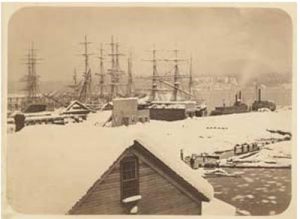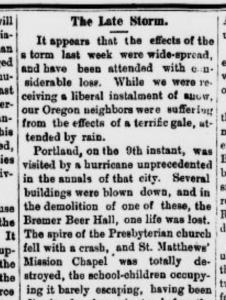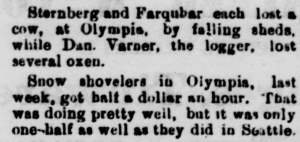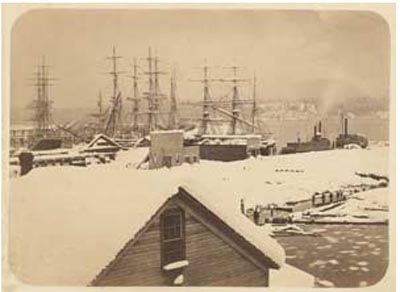Just after New Year’s Day, 1880, a typhoon lost speed deep in the Pacific Ocean and drifted into the Jet Stream, which pulled it toward the Pacific Northwest Coast.
 Washington and the non-native communities of the Northwest were not accustomed to the phenomena of remnants of tropical storms being picked up and thrown against the Pacific Coast. There was no warning as the wind came ashore and people at the time had no idea about the origins or the duration of the storm.
Washington and the non-native communities of the Northwest were not accustomed to the phenomena of remnants of tropical storms being picked up and thrown against the Pacific Coast. There was no warning as the wind came ashore and people at the time had no idea about the origins or the duration of the storm.
The storm boiled in the relative secret of the Pacific Ocean before landing somewhere on the northern edge of the Oregon Coast and taking a northeasterly path towards the Columbia River.

Recordings made it entirely possible that, after making landfall in Oregon, the track of the storm took it north to Olympia. Barometric readings in Portland (near where the center of the storm is assumed to have been) were actually less intense than the recordings in Olympia hours later.
As the storm and its precipitation tracked north from Oregon, the intense winds were traded for intense snow. For Olympia, the result was a massive snowstorm that smashed buildings, stopped trains, and downed trees.
Rev. A. Attwood was making a round trip by foot between Oakville and Tumwater that winter. He noted not only snow, but also raging streams that had transformed from small brooks to full-sized rivers, fallen timber and farm structures collapsing, killing livestock.

By the time he reached the stretch between Littlerock and Tumwater on his return leg, this is what Attwood saw:
The snow was from two to three feet deep, and in the gulches and low places on the north side of the trees and hills was much deeper than this. About half of the great forest trees, some of them 175 feet long and from three to six feet through, had been leveled by the storm.
Both the Northern Pacific railway and the Olympia-Tenino Railroad were blocked by snow and fallen trees. The Northern Pacific in particular was prevented from moving in at Tenino where 30 inches of snow covered the tracks.
One of only two deaths in Washington because of the storm was in Yelm where a man froze to death in the snowstorm. The Washington Standard newspaper in Olympia noted:
The weather was not intensely cold, and these victims must have been overcome by fatigue or stupor from the effects of which they did not rally until exposure had extinguished every spark of vitality.

The Great Gale of 1880, also hauntingly knows as “Stormking,” was the first relatively well-documented storm to hit the Pacific Northwest of the United States, with newspaper accounts tracking its progress and impacts across time. One newspaper reported, “The wind was from the northwest, and did not commence to blow violently until nearly 2 o’clock Friday afternoon.”
Scientists had also set up shop in the region, and were able to collect weather-related data. The Gale of 1880 certainly had hallmarks of a hurricane (which at one point it was), according to a sudden drop in atmospheric pressure recorded by Army officers and noted in the Oregonian:
The sudden and rapid falling of the barometer indicated a really fearful storm, and we are informed that such a declension of the mercury in the states east of the Rocky Mountains would have been regarded as a harbinger of a hurricane that but few if any buildings in Portland could have withstood.
















































